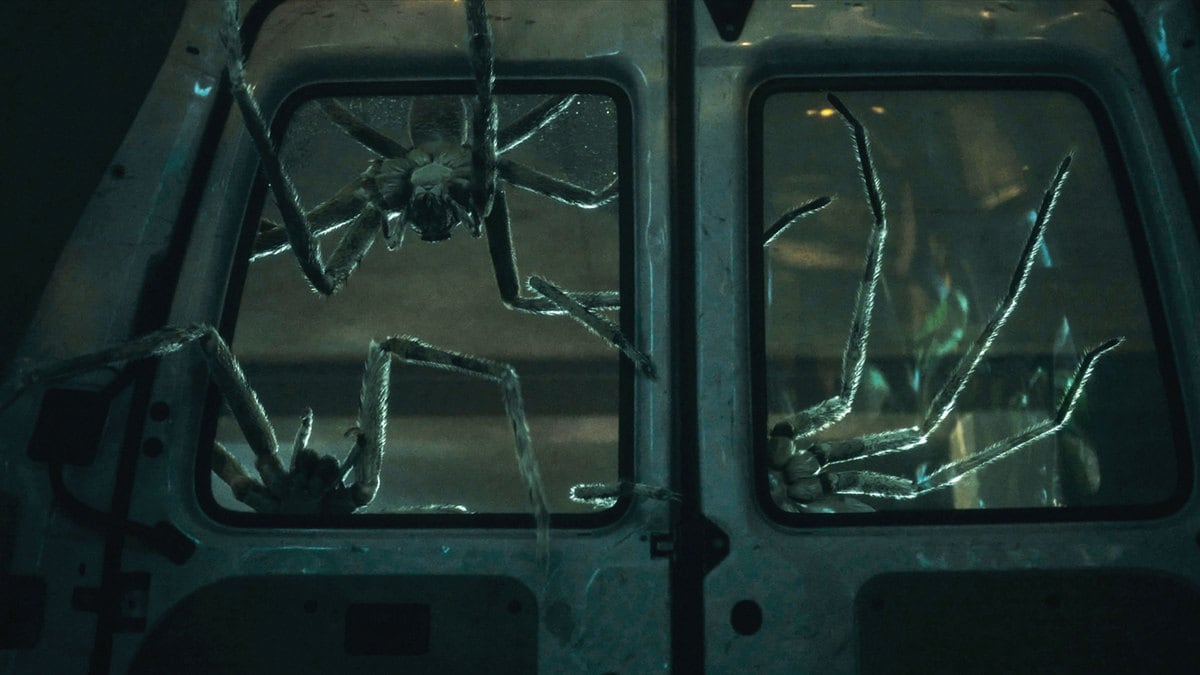“You have to understand why you’re afraid of spiders,” director Sébastien Vaniček tells The Daily Beast’s Obsessed. “And as soon as you understand that, there is no reason to be afraid.”
If we can boil humanity’s near-universal fear of spiders down to one thing, it would probably be the way they move. Blessed with eight legs and as many eyes dotted all around their bodies, spiders are directionally unpredictable: They can scuttle forwards, backwards, or side to side without warning or reason, running away from us, around us, or towards us as we valiantly leap atop the nearest chair, shrieking in fear.
This is exactly the spider quality that was important for Vaniček to get right. His feature debut Infested premieres on Shudder this week after taking the 2023 Venice Film Festival by storm, and prompting frenzied headlines about the army of real spiders used to engineer the movie’s skin-crawling scares. It’s so scary it’s already landed Vaniček a gig directing an upcoming Evil Dead movie.
“I love small things and living things,” Vaniček enthusiastically explained in an interview with The Daily Beast. “It was a pleasure to film them in close-ups and have really immense insects on the big screen. They’re really interesting creatures. It’s so cool to film them like this and to make people able to see how interesting they are, how complex they are.”

Theo Christine
ShudderInfested stars Théo Christine as Kaleb, a young resident of a derelict high rise in the suburbs of Paris. The building and its residents seem nearly forgotten by the wider world, barely able to pay for the pleasure of renting cramped apartments with unreliable plumbing and lights that work only half the time. Kaleb passes his time caring for his collection of insects, and one day comes across a rare specimen: a spider of unknown origin. He brings it home, oblivious to the fact that it’s about to produce an abundance of offspring that are not only deadly, but steadily increase in size, until the entire building is overrun and its residents are quarantined inside.
And, yes, they really did use 200 spiders on the set—but not all at once. “They are able to shoot for 10 seconds, and then after that they are tired, and you can’t have anything from them,” Vaniček explained. “You have to understand them, and understand that they are really fragile creatures. They are always afraid and they want to hide. When they are on the floor, they will run and they will seek a place in the shadow. They are able to run for about 10 seconds, and after just 10 seconds they are completely tired. You can put them on the wall and let them stay, and I can film them because I know they won't move.”
The arachnids in the film (even the ones extra-oversized by meticulous visual effects) are giant huntsman spiders (Heteropoda maxima), natives of Laos, and currently hold the title for largest spider in the world by leg span. Those legs were what Vaniček was looking for when choosing his small stars; he didn’t want to use tarantulas, which, despite the fact that they show up in countless horror movies, aren’t the type of spider most of us are used to seeing in our homes.
“I wanted a spider that you kind of recognize because you know this type of spider, everybody has one of these in their shower one day,” he said. “But I made them bigger. And with big legs like this you can understand that they will run really fast.”
Sudden bursts of speed are the huntsman’s calling card, but the deadly venom and extreme size are, thankfully, the film’s inventions. The spiders, like the human characters, are displaced, far from their familiar environment and trapped in a place they don’t want to be, beset on all sides by beings more powerful than them who have little regard for their well-being. The movie’s French title, Vermines (vermin), is a little more double-edged, drawing a parallel between the bugs and the humans, both undesirables seen as a nuisance or worse by the rest of society.

Infested
Shudder“It was a really interesting way to talk about xenophobia and the people who are judged for how they look or where they come from,” Vaniček said. “I think the spiders are the perfect example, because it’s a really small thing and it’s not dangerous at all but nobody wants a spider in their living room or in the bathroom. They are immediately judged, not because they are dangerous, but because we don’t like their shape and their look.” To this point, Vaniček was adamant that the spiders in the movie, dangerous though they are, are never shown as the aggressors: “They are victims because they were taken from their homeland, they don’t want to live in this building, and they are attacked by everybody. If you see the movie from the spider point of view, you will see that there is no scene where the spider attacks first. They are always attacked by someone and they defend themselves.”
Vaniček grew up not far from the building in which Infested is set, the Arènes de Picasso, a drum-shaped housing complex dominated on both ends by large windowed cylinders that look like something out of a Blade Runner movie. It’s a stunning work of architecture, and immediately calls to mind traps and containers and other enclosed spaces. “I come from the suburbs and the suburbs of France are our subjects,” he explained. “How people deal with problems in the suburbs is always the same story: You have to put it in a box and let it go and the problems will solve themselves. [The film] is not about how we deal with the problems inside the suburbs, it's how the external world will help us to deal with these problems. And the answer is always to open the box.”






